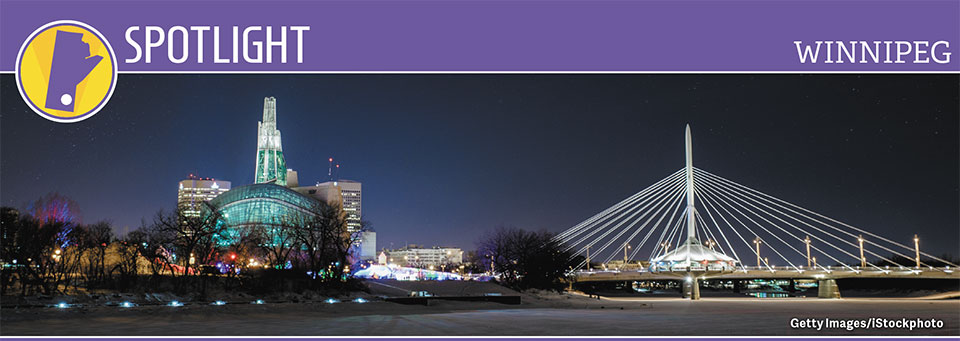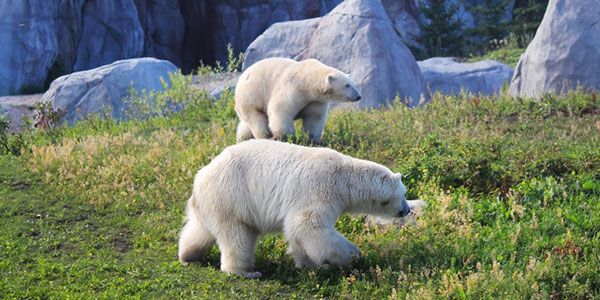

Winnipeg
Stop at a colorful crossroads on the prairie
At the junction of the Red and Assiniboine Rivers, the eighth-largest city in Canada pulses with a unique blend of European and First Nation cultures. Over the centuries, Winnipeg evolved from a major trading center to a vital hub for recreation and industry. Visitors can enjoy its urban pleasures or use it as a springboard for trips to the parks surrounding the city.
History
Named by the indigenous Cree people, Winnipeg translates into “muddy water,” describing the silt-heavy rivers that flow through the region. In 1738, the fur trapping industry put Winnipeg on the map as a major trading post. A century later, Winnipeg became a major stop on the Canadian Pacific Railway, mirroring the growth of its U.S. counterpart, Chicago. Indeed, leading up to World War I, the city’s rapid growth and bustling industry led observers to call it “the Chicago of the North.”
The railroad not only connected other parts of Canada to Winnipeg, but it also eventually provided a transportation link to the U.S. The trains brought an influx of new immigrants from Europe seeking to make a new home. Their legacy is felt in the rich blend of cultures that thrives in the city today.
Things to Do
Winnipeg’s history is highlighted by the Forks National Historic Site, where the Red and Assiniboine Rivers meet. This 54-acre historic park explores the 6,000-year history of the region’s First Nation Peoples through statues and interpretive exhibits.
Nearby, the Esplanade Riel Pedestrian Bridge takes visitors to St. Boniface, known as Winnipeg’s French Quarter. Founded in 1818 by French fur traders, St. Boniface is the largest French-speaking community west of the Great Lakes. From delectable French pastries to fashionable boutiques, the community celebrates its French heritage with flair.
For novice and pro anglers alike, Winnipeg’s proximity to a number of lakes offers ample opportunity to take home more than a mere “fish tale.” Other sports activities, including boating, golf and tennis, are just as accessible.

Nearby Assiniboine Park is home to some 200 species of animals, including polar bears, red pandas and snow leopards, all housed at Assiniboine Park Zoo, considered among Canada’s best. The Manitoba Museum places outer space, dinosaurs and buffalo all under one roof. Seasonal sightings of real live bison and migrating birds await visitors to nearby FortWhyte Alive, 640 acres of unspoiled prairie just south of Winnipeg. FortWhyte Alive offers a “Bison Safari,” a guided tour onboard a van to take visitors for a close-up view of the world’s 9th largest land animal.
The city’s Exchange District is a 20-block area designated as a National Historic Site, now filled with galleries, restaurants and a variety of shops. Perhaps no panoramic view of Winnipeg is better than that found at the Tower of Hope, the pinnacle of the Canadian Museum for Human Rights. Hieroglyphics are just part of the Hermetic Code Tour at the Manitoba Legislative Building, considered an architectural highlight of the city. The Winnipeg Art Gallery is another striking architectural building. Its collection of some 24, 000 works includes the world’s largest collection of art by the Inuit, members of the Eskimo tribes who first inhabited the most northern parts of North America stretching from northern Alaska to eastern Canada to Greenland.
Wonder how it feels to hold a $600,000 gold bar? Find out at the Royal Canadian Mint, which allows visitors to hold one (but not take it home!) during its guided tours. The mint produces coins for more than 70 countries. The Olympic Gold Medals for the 2010 Vancouver games were minted there.
For More Information
Tourism Winnipeg
855-PEG-CITY
Travel Manitoba
800-665-0040
